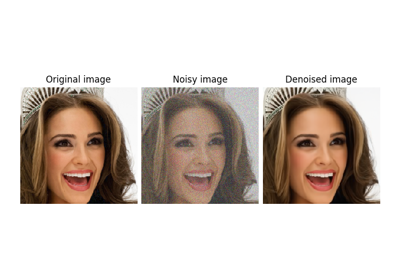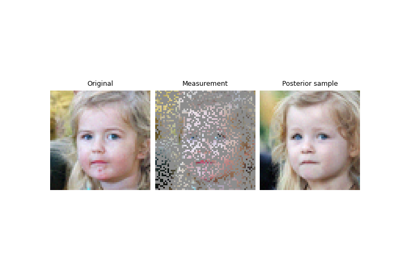VariancePreservingDiffusion#
- class deepinv.sampling.VariancePreservingDiffusion(denoiser=None, beta_min=0.0001, beta_max=5.0, alpha=1.0, solver=None, dtype=torch.float64, device=torch.device('cpu'), *args, **kwargs)[source]#
Bases:
DiffusionSDEVariance-Preserving Stochastic Differential Equation (VP-SDE).
This class implements the reverse-time SDE of the Variance-Preserving SDE (VP-SDE) Song et al.[1].
The forward-time SDE is defined as follows:
\[d x_t = -\frac{1}{2} \beta(t) x_t dt + \sqrt{\beta(t)} d w_t \quad \mbox{ where } \beta(t) = \beta_{\mathrm{min}} + t \left( \beta_{\mathrm{max}} - \beta_{\mathrm{min}} \right)\]The reverse-time SDE is defined as follows:
\[d x_t = -\left(\frac{1}{2} \beta(t) x_t + \frac{1 + \alpha}{2} \beta(t) \nabla \log p_t(x_t) \right) dt + \sqrt{\alpha \beta(t)} d w_t\]where \(\alpha \in [0,1]\) is a constant weighting the diffusion term.
This class is the reverse-time SDE of the VP-SDE, serving as the generation process.
- Parameters:
denoiser (deepinv.models.Denoiser) – a denoiser used to provide an approximation of the score at time \(t\): \(\nabla \log p_t\).
beta_min (float) – the minimum noise level.
beta_max (float) – the maximum noise level.
alpha (float) – the weighting factor of the diffusion term.
solver (deepinv.sampling.BaseSDESolver) – the solver for solving the SDE.
dtype (torch.dtype) – data type of the computation, except for the
denoiserwhich will usetorch.float32. We recommend usingtorch.float64for better stability and less numerical error when solving the SDE in discrete time, since most computation cost is from evaluating thedenoiser, which will be always computed intorch.float32.device (torch.device) – device on which the computation is performed.
*args – additional arguments for the
deepinv.sampling.DiffusionSDE.**kwargs – additional keyword arguments for the
deepinv.sampling.DiffusionSDE.
- References:
- sample_init(shape, rng)[source]#
Sample from the initial distribution of the reverse-time diffusion SDE, which is the standard Gaussian distribution.
- Parameters:
shape (tuple) – The shape of the sample to generate
rng (torch.Generator) – Random number generator for reproducibility
- Returns:
A sample from the prior distribution
- Return type:
Examples using VariancePreservingDiffusion:#

Using state-of-the-art diffusion models from HuggingFace Diffusers with DeepInverse

Building your diffusion posterior sampling method using SDEs

